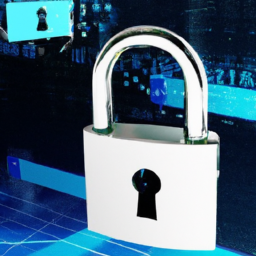How Do We Maintain Customer Trust After A Cyber Incident?
In the ever-evolving world of technology, cyber incidents have become an unfortunate reality for businesses. When faced with the aftermath of such incidents, the challenge lies not only in resolving the technical issues but also in rebuilding customer trust. This article explores strategies to navigate the aftermath of a cyber incident and maintain strong relationships with customers, ensuring their trust and loyalty remain intact. With a focus on open communication and proactive measures, businesses can effectively maneuver through the aftermath of a cyber incident, fostering trust and security in a digital landscape.
Develop a Communication Plan
In the face of a cyber incident, it is crucial to have a well-thought-out communication plan in place. By establishing a communication team, you can ensure that the right people are handling the task, exhibiting expertise, and coordinating efforts effectively. Designate members who possess strong communication and interpersonal skills to handle customer interactions and keep them informed throughout the incident.
Preparing key messages is another essential aspect of your communication plan. Craft clear and concise messages that address the incident, its impacts, and steps being taken to resolve the issue. These messages should be consistent across all communication channels and provide reassurance to customers that their concerns are being acknowledged and addressed.
Using multiple channels for communication is essential to ensuring that your messages reach a wide audience. Consider leveraging various platforms such as social media, emails, your company website, and even traditional media outlets. By utilizing a diverse range of channels, you can effectively reach your customers and keep them informed at each stage of the incident.
Be Transparent and Honest
Maintaining transparency and honesty is crucial when it comes to rebuilding customer trust after a cyber incident. Acknowledge the incident openly and proactively, which helps to build trust and indicates that you value transparency. Avoid attempting to downplay or hide the severity of the incident, as this can lead to further damage to your reputation and customer trust.
Providing timely updates throughout the incident is essential for keeping customers informed and involved in the resolution process. Regularly communicate the progress being made, any challenges encountered, and the steps being taken to prevent future incidents. This helps to reassure customers that you are actively working to address the situation and mitigate any potential impact.
Sharing learnings and enhancements after a cyber incident demonstrates your commitment to continuous improvement. Analyze the incident thoroughly to identify the root causes, gaps in security measures, or any vulnerabilities that were exploited. Communicate these findings to your customers and explain the steps you are taking to prevent similar incidents in the future. By sharing these insights, you can not only rebuild trust but also educate your customers about the importance of cybersecurity.
Ensure Data Protection
Protecting customer data is paramount in maintaining their trust after a cyber incident. Implementing strong security measures is the first step towards safeguarding sensitive information. This includes using robust firewalls, encryption protocols, and access controls. Regularly update and patch software to mitigate any known vulnerabilities and ensure that your security systems are up to date.
Encrypting data is an essential practice that should be followed to protect customer information from unauthorized access. This ensures that even if data is intercepted, it remains unreadable and unusable to anyone without the proper decryption key. Encrypting data both in transit and at rest adds an extra layer of protection and demonstrates your commitment to data security.
Regularly backing up data is another crucial aspect of data protection. By having multiple copies of data stored in secure locations, you can ensure that, in the event of a cyber incident or data loss, you can restore the affected systems and minimize the impact on your customers. Regularly test the effectiveness of your backup systems to guarantee their reliability.
Offer Support and Assistance
Providing support and assistance to affected customers is paramount in rebuilding trust and ensuring their continued loyalty. Create a comprehensive plan that includes clear guidance and resources for customers to navigate the aftermath of a cyber incident. This may include step-by-step instructions on what actions customers should take, how to monitor for potential identity theft, and who to contact for further assistance.
Assisting with identity theft protection is crucial, as customers may be at an increased risk of having their personal information compromised. Offer resources such as credit monitoring services or partnerships with identity protection agencies to help customers safeguard their identities. By providing these services, you can demonstrate your commitment to addressing the potential consequences of the incident.
Offering compensation or discounts can also help retain customer trust and loyalty. This shows that you take responsibility for the incident and are willing to provide tangible benefits to affected customers. Consider implementing a compensation program that offers refunds, discounts, or other incentives to customers who may have experienced financial loss or inconvenience as a result of the cyber incident.
Engage with Customers
Engaging with customers is essential in rebuilding trust and maintaining strong relationships. Actively listen to customer concerns and address them promptly and empathetically. By acknowledging their concerns and demonstrating that you understand their frustrations, you can foster a sense of trust and ensure they feel valued.
Encouraging feedback from customers provides valuable insights into their experiences and perceptions. Use surveys, online forums, and social media platforms to actively seek feedback about the incident and the measures you have implemented to address it. Take this feedback into account when making improvements, as it demonstrates your willingness to learn from your mistakes and adapt to better serve your customers.
Implementing customer suggestions can further strengthen customer trust and loyalty. Actively consider and evaluate the suggestions provided by your customers, and where appropriate, incorporate them into your company’s practices and policies. By involving customers in your decision-making processes, you show that their opinions matter and that you are committed to meeting their needs and expectations.
Educate Customers
Raising awareness about cybersecurity is crucial in arming your customers with the knowledge and tools to protect themselves. Regularly communicate the importance of cybersecurity measures and the risks associated with not following safe online practices. This can be done through email campaigns, social media posts, and blog articles that provide practical tips and guidance.
Providing tips for safe online practices helps customers understand the steps they can take to minimize their exposure to cyber threats. Focus on topics such as creating strong passwords, recognizing phishing attempts, and being cautious when sharing personal information online. By educating your customers, you empower them to be proactive in safeguarding their own information.
Offering cybersecurity training can further enhance your customers’ knowledge and abilities in protecting themselves online. Conduct webinars, workshops, or provide online training modules that cover various aspects of cybersecurity. This can range from basic awareness training to more advanced topics such as secure web browsing or securing home networks. By investing in your customers’ education, you build a more resilient and proactive user base.
Build a Strong Incident Response Plan
Establishing an incident response team is crucial to ensure a swift and effective response to cyber incidents. Designate individuals with the necessary technical expertise and knowledge of your systems to form this team. Define clear responsibilities and communication channels within the team to streamline coordination during an incident. Regularly assess and update your incident response team to align with evolving threats and technologies.
Conducting regular drills and testing is essential for assessing the effectiveness of your incident response plan. Simulate various types of cyber incidents and evaluate how well your team responds and follows the established procedures. Identify areas of improvement and update your plan accordingly to address any gaps or weaknesses. Regular training and testing will keep your team prepared and ensure a coordinated and efficient response when a real incident occurs.
Creating a comprehensive incident response plan is crucial for guiding your team’s actions during a cyber incident. Document the necessary steps to be taken when an incident occurs, including communication channels, external resources to engage, and predetermined decision-making processes. Ensure that the plan is accessible to all relevant team members and regularly review and update it to address new threats and vulnerabilities.
Collaborate with Industry and Government
Staying updated on best practices in cybersecurity is crucial in maintaining the trust of your customers. Stay informed about the latest industry trends, threat intelligence, and regulatory requirements. Actively engage with industry associations, attend conferences, and follow reputable cybersecurity publications to stay ahead of emerging threats and industry advancements.
Participating in information sharing initiatives allows you to collaborate with other organizations and share insights and best practices. Join industry-specific information sharing groups or collaborate with trusted partners to exchange information about cyber threats, vulnerabilities, or incident response strategies. By sharing information, you contribute to the collective defense against cyber threats and can better protect your customers.
Working with regulatory authorities is essential to ensure compliance with applicable laws and regulations. Establish relationships with relevant regulatory agencies and stay updated on any changes in legislation. Actively engage with regulators to address any concerns they have and demonstrate your commitment to meeting legal requirements. By working closely with regulatory authorities, you showcase your dedication to maintaining the highest standards of data protection and cybersecurity.
Monitor and Detect Potential Threats
Implementing intrusion detection systems (IDS) is crucial in detecting and preventing potential threats. These systems monitor network traffic and identify any suspicious or unauthorized activity. Regularly update and configure IDS systems to ensure their effectiveness in detecting evolving threats. In conjunction with intrusion detection, implement intrusion prevention systems (IPS) to proactively block or mitigate any identified threats.
Conducting regular vulnerability assessments is essential for identifying potential weaknesses in your systems. Perform penetration testing and vulnerability scans to assess the resilience of your infrastructure and applications. Address any identified vulnerabilities promptly and prioritize their remediation based on the potential impact on your customers and the organization as a whole. Regular assessments will help you stay ahead of potential threats and ensure the security of customer data.
Utilizing artificial intelligence (AI) and machine learning technologies can enhance your ability to detect and respond to cyber threats. Implement AI-powered algorithms that constantly analyze network traffic, user behavior, and system logs to identify anomalous patterns or potential indicators of compromise. Machine learning models can adapt and improve over time, making them effective in detecting emerging threats and minimizing false positives.
Establish a Culture of Trust
Prioritizing ethics and privacy is essential in building a culture of trust within your organization. Embed these principles into your company’s values and code of conduct, ensuring that all employees understand their role in protecting customer privacy and data. Conduct regular training sessions to educate employees about ethical data practices and emphasize the importance of maintaining customer trust.
Engaging in ethical data practices is crucial to preserving customer trust. Implement strict data protection and privacy policies that adhere to applicable laws and regulations. Minimize the collection and storage of personally identifiable information to reduce the risk of data breaches. Regularly review your data practices to identify any areas where further safeguards can be implemented.
Demonstrating a commitment to security is vital in maintaining customer trust. Implement robust security measures across all aspects of your organization, ranging from physical security to network infrastructure. Regularly communicate your security efforts to customers, such as through security newsletters or updates on your website. By consistently demonstrating your dedication to their security, you can foster a strong culture of trust.
In conclusion, maintaining customer trust after a cyber incident requires a comprehensive and multifaceted approach. By developing a communication plan, being transparent and honest, ensuring data protection, offering support and assistance, engaging with customers, educating them, building a strong incident response plan, collaborating with industry and government, monitoring and detecting potential threats, and establishing a culture of trust, organizations can effectively rebuild trust and instill confidence in their customers. Adopting these strategies will not only help to mitigate the immediate impacts of a cyber incident but also strengthen resilience against future threats.








